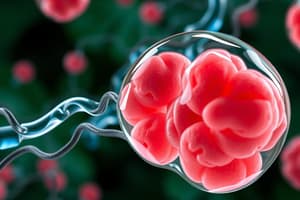Podcast
Questions and Answers
What is the requirement for testing cast pressure containing components?
What is the requirement for testing cast pressure containing components?
- 100% Surface Examination testing and 100% Radiography testing (correct)
- 50% Radiography testing and 100% Surface Examination testing
- No testing is required
- 50% Surface Examination testing and 50% Radiography testing
What is the purpose of grinding casting surface irregularities?
What is the purpose of grinding casting surface irregularities?
- To add a protective coating
- To remove sharp edges and burrs
- To remove surface irregularities (correct)
- To remove rust and dirt
After hydrostatic testing, what is the next step for the valve?
After hydrostatic testing, what is the next step for the valve?
- It is partially disassembled
- It is fully disassembled (correct)
- It is ready for installation
- It is reassembled with new components
What is a permitted cleaning method for valve components?
What is a permitted cleaning method for valve components?
What is a requirement for valve components after hydrostatic testing?
What is a requirement for valve components after hydrostatic testing?
Why is it important to ensure valve components are free from burrs and sharp edges?
Why is it important to ensure valve components are free from burrs and sharp edges?
What is the purpose of packaging non-metallic sealing products in hermetically sealed plastic bags?
What is the purpose of packaging non-metallic sealing products in hermetically sealed plastic bags?
What standard does the type-testing of Gate valves follow?
What standard does the type-testing of Gate valves follow?
Which of the following valve types follows the API 599 standard?
Which of the following valve types follows the API 599 standard?
What is a requirement for non-metallic sealing product manufacturers?
What is a requirement for non-metallic sealing product manufacturers?
What specification does the type-testing of Globe valves follow?
What specification does the type-testing of Globe valves follow?
What is the significance of the note mentioned in the table?
What is the significance of the note mentioned in the table?
What factors should the valve manufacturer consider when extending a qualification test to a product range?
What factors should the valve manufacturer consider when extending a qualification test to a product range?
Which of the following valve types follows the IOGP S-562 standard?
Which of the following valve types follows the IOGP S-562 standard?
What is the effective date for valves to meet the requirements of section 5.1.4?
What is the effective date for valves to meet the requirements of section 5.1.4?
What type of testing is required for valve designs categorized in Table 1 of ASME B16.34?
What type of testing is required for valve designs categorized in Table 1 of ASME B16.34?
What standard does the type-testing of Butterfly valves follow?
What standard does the type-testing of Butterfly valves follow?
What materials are mentioned in the context of valve designs in ASME B16.34?
What materials are mentioned in the context of valve designs in ASME B16.34?
Why is stem packing protection important when the stem installation is orientated below horizontal?
Why is stem packing protection important when the stem installation is orientated below horizontal?
What is the purpose of type-testing in the context of valve manufacturing?
What is the purpose of type-testing in the context of valve manufacturing?
Flashcards are hidden until you start studying
Study Notes
Valve Manufacturing and Testing
- The valve manufacturer shall ensure the non-metallic sealing product manufacturer has a procedure describing critical processes, controls, inspections, hold points, and records to demonstrate that parts are manufactured free from grease and oil and suitable for oxygen service.
- Non-metallic sealing products shall be packaged in a hermetically sealed plastic bag to prevent contamination.
Casting and Surface Preparation
- Cast pressure-containing components shall receive 100% Surface Examination testing and 100% Radiography testing.
- Valve components shall be free from burrs, sharp edges, rust, dirt, or any other foreign particulates.
- Casting surface irregularities shall be removed by grinding.
- All surfaces shall be smooth.
Assembly, Testing, and Inspection
- Valves shall be assembled and subject to hydrostatic shell and seat testing per the applicable valve design code.
- After hydrostatic testing, the valve shall be fully disassembled.
- Valve components shall be cleaned and free of any contaminants and organic substances (e.g., oil, grease, lubricants, adhesives, preservatives).
- Permitted cleaning methods include alkaline (aqueous) cleaning and vapour degreasing using solvents as per EIGA 33/18.
Fugitive Emission, Seat Performance, and Operating Torque Type-Testing
- Valve designs shall be qualified by type-testing in accordance with the specified industrial type-testing standard.
- Type-testing shall be performed on valves manufactured after January 1, 2023.
- The valve manufacturer's written procedure for rising stem designs shall follow modified ISO 23632 to account for the design.
- The valve manufacturer shall consider the effect of factors such as assembly loads, actuator weight, actuator orientation, actuating closing and opening loads, and stroke speeds, stem orientation, stem packing protection, and specified external loads when extending a qualification test to a product range.
Studying That Suits You
Use AI to generate personalized quizzes and flashcards to suit your learning preferences.




